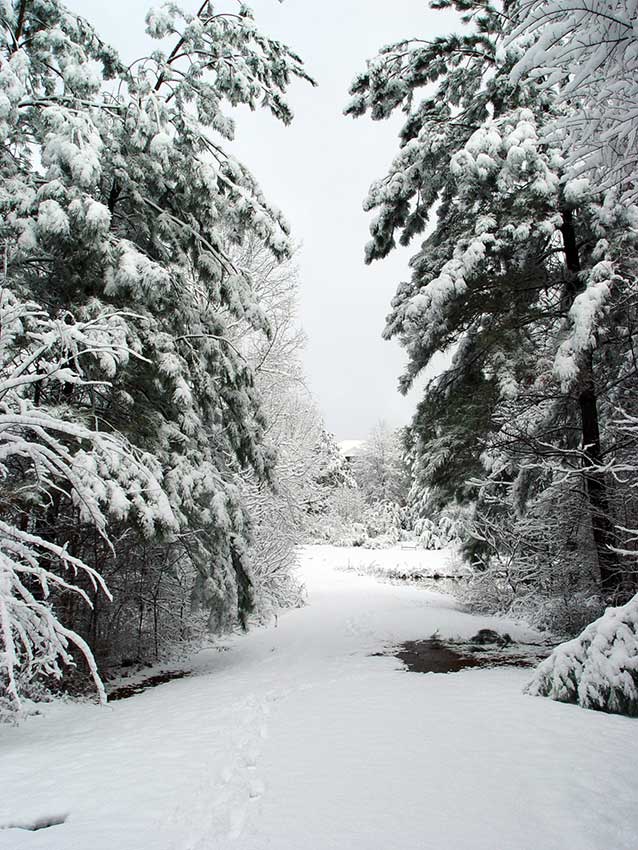RiskVA
Snowy Winter Wonderland – Maybe 24 Jun 2015
During the night of February 11th, snow moved into east Texas and left many places around the Nacgodoches area with 4-6 inches of the white stuff. Dallas staggered under 12 ½ inches and things pretty much came to a standstill for a short time.
I lived in the Dallas area for 8 years when I was a kid. Before that I lived with my family in Michigan. Years intervened during which I lived in Texas, California, Nevada, Pennsylvania and Maine. In December of 1990 we moved to Texas and it was quickly obvious I had forgotten some things about the Lone Star State. Shortly after our arrival a light powdered sugar dusting of snow fell. Church was cancelled that weekend. We snickered. The following weekend the snow was gone but there was a thin, barely perceptible glaze of ice on tree branches and shrubs. Church was cancelled again. We laughed out loud. However, since then I’ve realized that most people here simply don’t have the experience to drive well on frozen precipitation. During the recent snowfall the Nacogdoches Police Department responded to more than 20 storm related accidents. But don’t take that as an insult. When the first snows of winter fall in colder climates people who ought to know better also spin wildly, slipping, sliding and crashing into each other. Auto body shops see an immediate up-tick in their income.
And is isn’t just drivers who suffer. Pedestrians are victims too. While living in Maine my feet suddenly went out from under me while I was trying to open our garage door. I cracked a rib or two and smacked my head so hard on the ice-covered driveway that my wife heard the crack in the house! Knocked myself silly. It took several weeks for my ribs to get back to normal. Can’t say I received a whole lot of sympathy, just smart comments about my less than graceful ice dancing performance.
So what good is snow? Snow that remains on the ground is good insulation. The interlocking crystals trap billions of tiny air pockets and help keep the ground from freezing. Ground dwelling mammals enjoy warmer conditions in their burrows and owls can see their prey more easily against the snow. But, many other birds and mammals find it harder to locate food.
For generations Inuits in the far north have made igloos out of snow. Snow, not ice. They cut large blocks of snow to create their classic winter shelters. Ice blocks aren’t used in igloo construction because they contain no insulating trapped air pockets. Even a pile of snow can be hollowed out to make a survival shelter called a quinzee.
For me snow storms and snowy landscapes are simply beautiful. The rough edges of everything are smoothed and muted. A great silence descends over the land. The insulating qualities of snow allow it to absorb sound too. I enjoy walking through the snow. Extremely cold snow squeaks under foot and crunches when it’s warmer.
Clear nights after a snowstorm are special experiences. Stars stud the black skies like shattered diamonds on velvet. A full moon on the snow is truly magic. Snow crystals glitter and the night become so bright you can read a book without artificial light.
Years ago, I cross country skied with a bunch of crazy Canadians at 2 o’clock in the morning in northern Manitoba. The moon was full. It was about 30 below zero and you could hear trees popping like muted rifle shots as moisture in them froze causing them to burst. Jubilant and carefree, we slid over the hissing, squeaking snow howling like wolves – and real wolves howled back. Sent chills down my back. The air was so cold I could feel ice forming on my nasal hairs when I inhaled. We were all younger then and probably a little nuts in those days, but what an experience that was! I’d do it over again in a heartbeat.
Yes, I still like snow but in limited amounts and for short duration. During our years in states north of the Mason-Dixon Line, early season snow was always fun. But, when it was still coming down in April, everyone’s sense of humor was sorely tested. Brief glimpses of real winter in the forests of Deep East Texas are plenty for me now.
Dr. Risk is a professor emeritus in the College of Forestry and Agriculture at Stephen F. Austin State University in Nacogdoches, Texas. Content © Paul H. Risk, Ph.D. All rights reserved, except where otherwise noted. Click paulrisk2@gmail.com to send questions, comments, or request permission for use.


